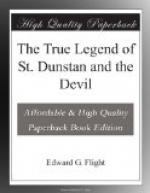Another solution suggests itself. Possibly the horse-shoe, even if genuine, was not affixed until after the Wicked One had already got possession. In that case, not only would the charm be inefficacious to eject him, but would actually operate as a bar to his quitting the premises; for that eminent jurisconsult, Mephistopheles himself, has distinctly laid it down as “a law binding on devils, that they must go out the same way they stole in.” Nailing up a shoe to keep the devil out, after he has once got in, is indeed too late; and is something like the literary pastime of the “Englishman,” who kept on showing cause against the Frenchman’s rule, long after the latter had, on the motion of his soldiers, already made it absolute with costs.
There is one other circumstance the author begs to refer to, from a desire to dispel any uneasiness about our relations with the Yezidi government. The late distinguished under-secretary for foreign affairs, as every one knows, not regarding as infra dig. certain great, winged, human-headed bulls,[2] that would have astonished Mr. Edgeworth, not less than they puzzle all Smithfield, and the rest of the learned “whose speech is of oxen,” has imported those extraordinary grand-junction specimens, which, with their countryfolk, the Yezidis, Dr. Layard has particularly described in his book on Nineveh. When speaking of the Yezidis, he has observed, “The name of the evil spirit is, however, never mentioned; and any allusion to it by others so vexes and irritates them, that it is said they have put to death persons who have wantonly outraged their feelings by its use. So far is their dread of offending the evil principle carried, that they carefully avoid every expression which may resemble in sound the name of Satan, or the Arabic word for ‘accursed.’ Thus, in speaking of a river, they will not say Shat, because it is too nearly connected with the first syllable in Sheitan, the devil; but substitute Nahr. Nor, for the same reason, will they utter the word Keitan, thread or fringe. Naal, a horse-shoe, and naal-band, a farrier, are forbidden words; because they approach to laan, a curse, and m[=a]loun, accursed.”—Layard, vol. i. p. 297.
[Footnote 2: A sister countryman,—a bull is excusable when discoursing of bulls,—on seeing the monster at the Museum, exclaimed, “Faith! the great Dan himself couldn’t repale that union, at all, at all, after ’twas once put together.” Some suppose this bull to be typical of a foreign John Bull, the head representing the Crown, the fine feathers the Lords, and the rest the Commons.]
Notwithstanding all this, the author has the pleasant satisfaction of most respectfully assuring his readers, on the authority of the last Yezidi Moniteur, that the amicable relations of this country with the Yezidi government are not in the slightest danger of being disturbed by this little book; and that John Bull is, at present, in no jeopardy of being swallowed up by those monstrous distant cousins of his, of whom Mr. Layard has brought home the above-mentioned speaking likenesses.




